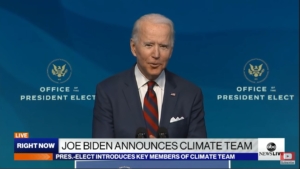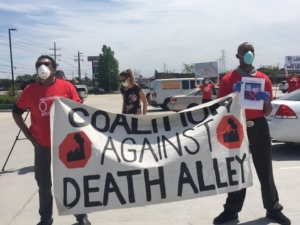From WOTUS to POTUS: Environmental Uncertainty in the Next Administration
Over the past several weeks, we have dived deep into the increasingly permanent state of regulatory uncertainty in Washington. Besides perhaps trade policy, there is no arena in which this state is more prevalent than the various and sometimes obscure environmental rules that govern everything from energy to agriculture to transportation to infrastructure to manufacturing and beyond. No matter who wins in November, the litigation of these key rules – in courts of public opinion as well as law – will continue unabated.
Beyond what happens with the controversial Paris Climate Accord, public affairs professionals can expect continued debate on an alphabet soup of rules like WOTUS, NEPA, ACE, TSCA, and beyond. How these rules are written and implemented will determine how industries can operate and what it will cost the consumers they serve. To prepare for what comes next in these debates, and ensure you know which acronym to deploy when, here’s what you need to know:
The Next Administration’s Application Of The Clean Water Act Can Set Industries Back Or Move Them Forward. The Obama Administration 2015 “Waters of the United States” (WOTUS) update to the Clean Water Act angered farmers, developers, and other critics, who argued WOTUS created onerous bureaucracy surrounding land use and increased uncertainty. In 2020, the Trump Administration replaced WOTUS with the Navigable Waters Protection Rule to “streamline the definition so that it includes four simple categories of jurisdictional waters.” Environmental activists and their allies argue Trump’s “Dirty Water Rule” “significantly reduce[d] the range of protected wetlands” and turned to the courts to stall or prevent its implementation. Because Clean Water Act rules can be challenged in any of the nation’s nearly 100 federal courts, opponents intend to continue flooding the courts with challenges, while supporters, like agriculture advocates and homebuilding coalitions, are preparing to fight back.
Subscribe to Receive Insights
"*" indicates required fields
- What Happens Next? See You In Court. If President Trump wins a second term, opponents of his rule will double down on their legal challenges, leaving the EPA to fight a multifront war in the courts. If Vice President Biden is elected, public affairs professionals can anticipate more stringent regulations, leaving key industries in limbo as they try to figure out whether these rules will ebb or flow.
One Reason Infrastructure Week Feels More Like Groundhog Day: NEPA. Both Republicans and Democrats say they want more infrastructure, but the maze of federal regulations make such investments difficult, with time-consuming, labor-intensive, and expensive environmental rules slowing progress. The “Magna Carta” of these laws, the National Environmental Policy Act (NEPA), has for 50 years required federal agencies to produce “environmental impact statements” to determine the effects of proposed projects such as highways or energy projects and given community and outside stakeholders the ability to challenge or appeal these assessments. As we’ve noted in the past, the Trump Administration has advanced reforms of NEPA to “ensure that the Federal environmental review and permitting process for infrastructure projects is coordinated, predictable, and transparent.” Supporters say that this streamlining untangles a bureaucratic web that inhibits the construction of worthwhile projects. Opponents claim a weaker NEPA would “sell out our clean air, clean water, and safe climate” to corporations by lessening environmental and community activists’ ability to raise concerns.
- What Happens Next? Building Projects Keeps Getting Harder. If President Trump is re-elected, his administration will likely be forced to defend his NEPA reforms in court for years to come. If Joe Biden is elected, the outcome of NEPA reform remains unclear. Biden will likely look to rollback President Trump’s NEPA reforms, while still attempting to follow-through on his commitment to spend $2 trillion in infrastructure. Without adjustments to NEPA’s rules, however, getting projects – even environmentally friendly ones like renewable energy generation – will prove more difficult for his administration.
The Never-Ending Power Emissions Debate. In 2018, the Trump Administration proposed the Affordable Clean Energy (ACE) Rule to “establish emission guidelines for states” regarding power plants. ACE replaced the Obama Administration’s Clean Power Plan, which the Trump EPA argued had exceeded EPA’s authority under the Clean Air Act. Democratic attorneys-general from states across the U.S. filed suit in August 2019 challenging ACE, insisting that the new rule only made modest emissions reductions, increased carbon emissions and pollutions in more than a dozen states, and greatly curtailed states’ abilities to create their own compliance requirements on energy companies.
- Will It “Land at Some Point”? Court watchers say that the Trump Administration has an uphill battle in defending their regulation, and experts say that, should Biden win, ACE will never get a ruling. A Biden EPA will almost certainly replace ACE with a rule even more stringent than the Clean Power Plan. Should a Biden Administration enact these greater CO2 emission limitations, Politico’s Alex Guillen observes, “get ready for yet another day of marathon arguments over Biden’s replacement rule in another four years or so. (Though notably it’s been 13 years since the Supreme Court said EPA has greenhouse gas authority, so something’s gotta land at some point.).”
TSCA May Have More Drama Than La Tosca As Chemical Fights Compound Uncertainty For Regulators And Industries. Created in 1976, and amended in 2016, the Toxic Substances Control Act (TSCA) regulates new or already existing chemicals. Critics of the administration argue the Trump EPA is too “industry-friendly,” and is endangering the public by exposing them to chemicals that can’t be confirmed as harmless. In November 2019, the 9th Circuit Court of Appeals agreed, gearing up yet another fight for a Trump Administration in a second term – or for a prospective President Biden to ditch once he’s in office. Moreover, industry suspects a Biden Administration “could interpret TSCA, and the many legal, science and policy issues it invites,
- But There’s More: Debate On This Chemical Could Upend Medical Supply Chains Amidst The Pandemic. Beyond the TSCA fights, under outside pressure EPA has indicated it will consider action on an increasingly high profile chemical in 2021: ethylene oxide (EtO). EtO is a common sterilizer used on medical devices, but it has also been deemed a carcinogen by the EPA. As EPA looks to regulate the gas in 2021, any closures of EtO plants could bring the United States to “the cusp of a major medical logistical failure,” all while the country tries to navigate the COVID-19 pandemic.
CAFE Standards Remain On The Menu… Arguing it would allow the auto industry to make cheaper, safer vehicles, the Trump Administration finalized a roll back of the Obama era Corporate Average Fuel Economy (CAFE) standards in March 2020. The administration also upped the CAFE standards fight by revoking California’s federal waiver on emissions, calling for a uniform national standard and denying California’s assertion that the state needs more stringent emissions standards.
- … And California Just Upped The Ante. The CAFE fight will certainly continue beyond election day, especially with California’s new mandate that all new passenger cars and trucks sold in the state much be emissions free by 2035, which now has found interest among Congressional Democrats as a national objective. While Biden is likely to restore California’s CAFÉ waiver and allow the state to move forward with such a ban, Trump’s EPA Administrator has indicated his agency would need to approve California’s ban on gas-powered vehicles.
Regardless Of Who Wins In November, Public Affairs Professionals Will Have A Daunting Task In These Environmental Debates. Energy and environmental issues are among the top concerns for any presidential administration, but the increasing contentious fights over how to address climate change means that each regulatory action becomes a knock-down, drag-out fight. Ever-changing rules combined with stalled implementation compound uncertainty for sectors that require reliable, stable policy direction to get things done. Their public affairs professionals always have their work cut out for them, but now more than ever, affecting policymaking remains a daunting task. With Delve in your corner, you can better anticipate what’s next.



